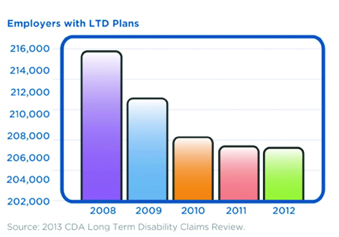 |
 |
 |
Benefits Products & Services Ability to work: An asset worth protecting In the shadow of ACA and SSDI turmoil: A disability benefits opportunity By Thomas A. McCoy, CLU
It hasn't been easy for disability sellers to shake off the effects of the financial crisis that began five years ago. (See graph above.) While recent gains in the job market are a hopeful sign for many benefits products, disability included, employment numbers are only one influence on benefits product sales. There's also the Affordable Care Act, an 800-pound gorilla in the room. "Both brokers and HR executives are trying to figure out what they need to do under the Affordable Care Act," says Barry Lundquist, president of the Council for Disability Awareness (CDA). "What are my competitors going to do? What are my options? The regulations aren't clear yet in many cases, so that's sucking up a lot of oxygen in the room." Thinking optimistically, the layoffs of the past few years may have helped motivate both plan participants and HR executives to consider the value of a steady income, and therefore the need to protect that income against the potentially devastating effects of a disability. The CDA, whose members write about 75% of the commercial disability business in the United States—most of it in employer-sponsored plans—recently published its 2013 Long Term Disability Claims Review. It included results from a recent CDA survey of the attitudes of HR executives and benefit plan participants toward long-term disability. The study reported that HR professionals (84%) and employees (90%) agree that it is very important to prepare for a disability. HR executives, however, vastly underestimated the value that employees place on preparing for a disability. Only 26% of the HR people believed that employees would rate preparing for a disability as very important. The survey also showed that the HR people and plan participants have different views concerning the most common causes of a long-term disability, the likely severity of such a disability, and its financial impact on the person who is disabled. Both HR executives and plan participants underestimate the actual statistical likelihood of a worker experiencing a long-term disability during his or her career. The study results clearly point toward a need for employers to educate their workers about disability. About half (48%) of employees said they did not have enough information about purchasing disability insurance. Overall, the study found that the disability education that employers are willing to consider is skewed toward providing information, rather than actual guidance. Almost three-quarters (72%) of the HR executives said it is their responsibility to help employees understand their benefits; 57% said they should provide direction or recommendations. When asked if their company has a responsibility to help employees protect their incomes from the risk of disability, the affirmative responses dropped to 48%. The CDA's Lundquist notes that any involvement HR people may have in the employee's benefit selection process is coming at a time when the pendulum has swung toward voluntary benefits. "To the extent that employees become more responsible for selecting and paying for their benefits, they need to be armed with the right information to make the right choices. I hope the HR people will help them make the right choices. "For the HR person," Lundquist continues, "I just think about what it would be like to sit across the table from someone who can no longer work, or maybe a family member of an employee who can no longer work, and have to explain what's going to happen. It's just a horrible conversation. 'Your last day of employment is whatever. Your benefits stop on that day.' To think about a person never having any income—it's like a financial death sentence." It's the specter of this kind of catastrophic risk from a disability that was behind the formation of the Social Security Disability Income (SSDI) program in 1960. This well-meaning program now provides an average monthly income of $1,130 to approximately 8.8 million disabled persons (more than 5% of the U.S. workforce). The number of SSDI claimants has grown by 59% over the last decade, and, as a result, the program is now on track to exhaust its resources by 2016 without significant increases in funding or cutbacks in services. Many people no doubt will find it tiresome and troubling to be dealing with yet another government program funding crisis. However, the public discussion of SSDI's problems may serve a useful purpose if it raises public awareness of the importance of disability protection and the availability of coverage in the private market. A primary difference between the private market and SSDI, says Lundquist, is the approach to return-to-work. "Let's say the worker with private disability coverage has injured his back (non-work related, and therefore not compensable under workers comp). The longer that person is at home, the harder it is to return to work. So the disability insurer gets involved right away." This can involve coordinating care with physicians and exploring possible modified work regimens. "Under SSDI, the approval process might take six or seven months," says Lundquist. By the time the worker qualifies, there isn't much likelihood of his coming back to work, he says. Michel Boskin, who served as chairman of the Council of Economic Advisers under President George H.W. Bush, in a recent op-ed column in The Wall Street Journal, called SSDI "a Hotel California—you check in with a disability and don't leave unless you die or convert to Social Security retirement at age 66." In 2009, he points out, only 0.8% of those on SSDI returned to work or gave up the benefits for other reasons. Boskin, who is currently an economics professor at Stanford, says that to become more sustainable, SSDI needs to adopt private market practices such as early claims intervention, flexible work options and experience rating of employers' contributions. So the stage is set for the debate over SSDI funding. Some observers may want to draw parallels between SSDI and the ill-fated long-term care insurance initiative that was originally part of the ACA, but abandoned when it was found to be economically unsound. SSDI, though, has a record in the marketplace of more than 50 years. It isn't about to be scrapped. However, its future may be shaped by what it can learn from the private disability market. The CDA's recent study of workplace attitudes toward disability found that both HR professionals and plan participants fundamentally believe in the idea of protecting incomes. In fact, they both rated income protection as more important than medical insurance, retirement savings, an investment in a home or other savings. With that kind of acceptance, and an improving job market, the outlook for employer-based disability insurance looks encouraging.
|
|||||
| |||||
| ©The Rough Notes Company. No part of this publication may be reproduced, translated, stored in a database or retrieval system, or transmitted in any form by electronic, mechanical, photocopying, recording, or by other means, except as expressly permitted by the publisher. For permission contact Samuel W. Berman. |

